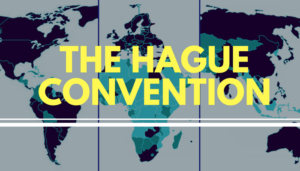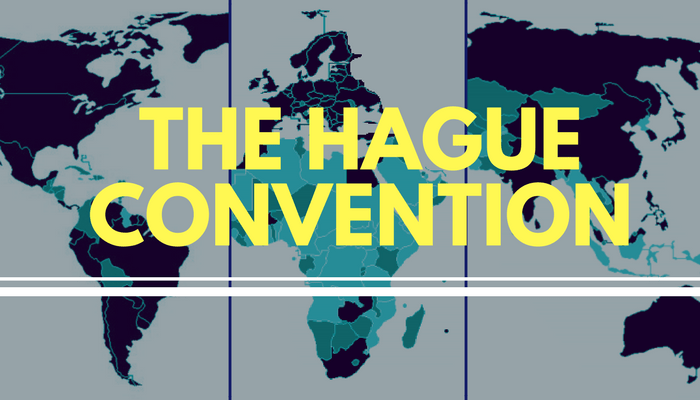The Hague Convention on the Civil Aspects of International Child Abduction or Hague Abduction Convention is a multilateral treaty developed by the Hague Conference on Private International Law(HCCH) that provides an expeditious method to return a child internationally abducted by a parent from one member country to another.
The Convention was concluded 25 October 1980 and entered into force between the signatories on 1 December 1983. The Convention was drafted to ensure the prompt return of children who have been abducted from their country of habitual residence or wrongfully retained in a contracting state not their country of habitual residence.
The primary intention of the Convention is to preserve whatever status quo child custody arrangement existed immediately before an alleged wrongful removal or retention thereby deterring a parent from crossing international boundaries in search of a more sympathetic court. The Convention applies only to children under the age of 16.
As of May 2018, 98 states are party to the convention. In 2017, Tunisia and Jamaica acceded to the convention.

source: Wikipedia.org
Procedural nature
The Convention does not alter any substantive rights. The Convention requires that a court in which a Hague Convention action is filed should not consider the merits of any underlying child custody dispute, but should determine only that country in which those issues should be heard. Return of the child is to the member country rather than specifically to the left-behind parent.
The Convention requires the return of a child who was a “habitual resident” in a contracting party immediately before an action that constitutes a breach of custody or access rights. The Convention provides that all Contracting States, as well as any judicial and administrative bodies of those Contracting States, “shall act expeditiously in all proceedings seeking the return of a children” and that those institutions shall use the most expeditious procedures available to the end that final decision be made within six weeks from the date of commencement of the proceedings.
Wrongful removal or retention
The Convention provides that the removal or retention of a child is “wrongful” whenever:
“a. It is in breach of rights of custody attributed to a person, an institution or any other body, either jointly or alone, under the law of the State in which the child was habitually resident immediately before the removal or retention; and
“b. at the time of removal or retention those rights were actually exercised, either jointly or alone, or would have been so exercised but for the removal or retention.” These rights of custody may arise by operation of law or by reason of a judicial or administrative decision, or by reason of an agreement having legal effect under the law of the country of habitual residence.
“From the Convention’s standpoint, the removal of a child by one of the joint holders without the consent of the other, is . . . wrongful, and this wrongfulness derives in this particular case, not from some action in breach of a particular law, but from the fact that such action has disregarded the rights of the other parent which are also protected by law, and has interfered with their normal exercise.”
Habitual residence
The Convention mandates return of any child who was “habitually resident” in a contracting nation immediately before an action that constitutes a breach of custody or access rights. The Convention does not define the term “habitual residence,” but it is not intended to be a technical term. Instead, courts should broadly read the term in the context of the Convention’s purpose to discourage unilateral removal of a child from that place in which the child lived when removed or retained, which should generally be understood as the child’s “ordinary residence.” The child’s “habitual residence” is not determined after the incident alleged to constitute a wrongful removal or retention. A parent cannot unilaterally create a new habitual residence by wrongfully removing or sequestering a child. Because the determination of “habitual residence” is primarily a “fact based” determination and not one which is encumbered by legal technicalities, the court must look at those facts, the shared intentions of the parties, the history of the children’s location and the settled nature of the family prior to the facts giving rise to the request for return.
Nom compliance
2016 US Annual Report on International Parental Child Abduction
Noncompliance with the terms and spirit of the Hague Convention has been a particularly difficult problem in the practical implementation of the Convention. In 2014, the United States declared Brazil, Mexico, Romania, and Ukraine as “Countries with Enforcement Concerns.” Additional countries are listed and reference to the most recent report should be made by concerned parties.
The Cuellar Versus Joyce case was an example of the difficulties facing left behind parents applying to the US Central Authority.
Interpretation of article 13b: no return in case of “grave risks”Edit
The principal purpose of the Abduction Convention is to cause the prompt return of a child to his or her “habitual residence.” In certain exceptional cases under Article 13b, the court’s mandatory return obligation is changed to a discretionary obligation, specifically, “the judicial or administrative authority of the requested State is not bound to order the return of the child if the person, institution or other body which opposes its return establishes that there is a grave risk that his or her return would expose the child to physical or psychological harm or otherwise place the child in an intolerable situation.” The duty to return a child is however not abrogated by a finding under Art. 13(b) but merely changes from mandatory to discretionary.
In the primary source of interpretation for the Convention, the Explanatory Report, Professor E. Perez–Vera noted the following:
“it would seem necessary to underline the fact that the three types of exception to the rule concerning the return of the child must be applied only so far as they go and no further. This implies above all that they are to be interpreted in a restrictive fashion if the Convention is not to become a dead letter. In fact, the Convention as a whole rests upon the unanimous rejection of this phenomenon of illegal child removals and upon the conviction that the best way to combat them at an international level is to refuse to grant them legal recognition. The practical application of this principle requires that the signatory States be convinced that they belong, despite their differences, to the same legal community within which the authorities of each State acknowledge that the authorities of one of them—those of the child’s habitual residence—are in principle best placed to decide upon questions of custody and access. As a result, a systematic invocation of the said exceptions, substituting the forum chosen by the abductor for that of the child’s residence, would lead to the collapse of the whole structure of the Convention by depriving it of the spirit of mutual confidence which is its inspiration
State parties
As of May 2018, the Convention has 98 parties. The last states to accede to the Convention were Tunisia and Jamaica in 2017.






